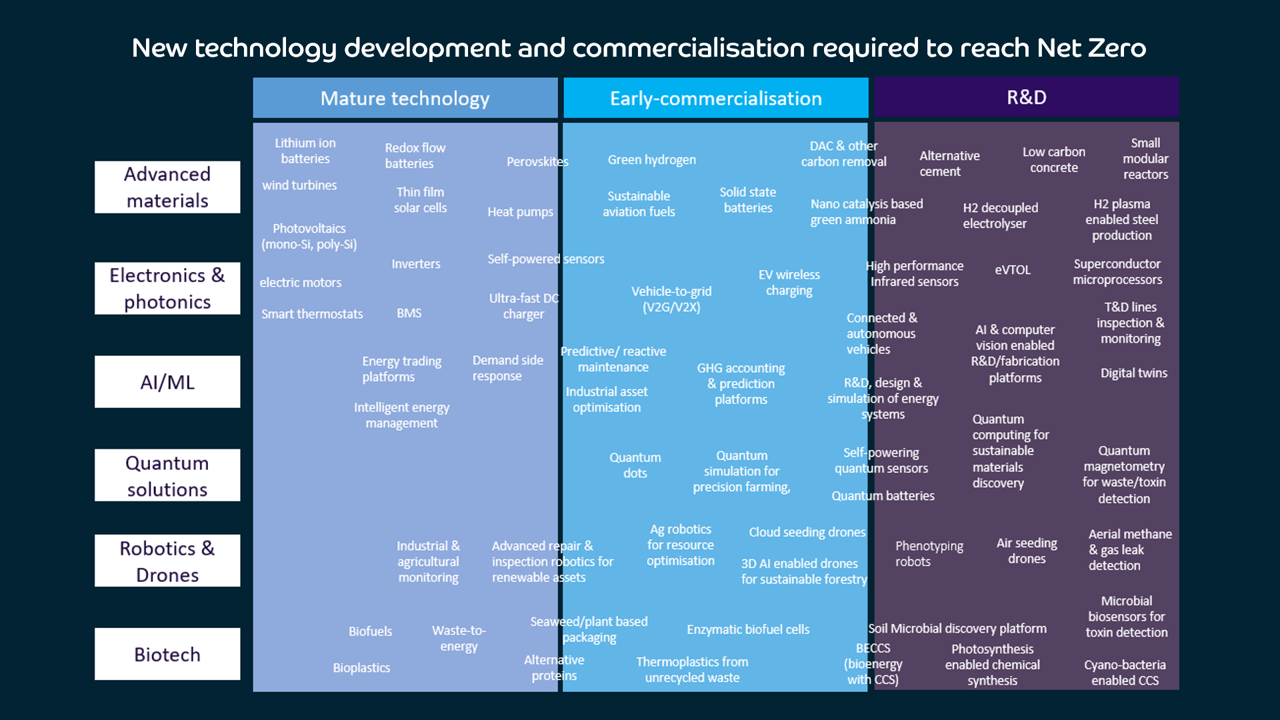Deeptech: the essential catalyst for decarbonisation
Deeptech: the essential catalyst for decarbonisation
What do the Haber Bosch process, the light bulb and chocolate have in common? They are all examples of century old successful deep tech innovations that changed the world and led to affordable and accessible products which are so ubiquitous in how we live that today one might say we take them for granted. The Haber Bosch process may be one of the most important processes invented during the Industrial Revolution that significantly increased the yield from agriculture and contributed to the global population boom by enabling the production of affordable fertiliser. The light bulb changed the way we live and work, created a social order after dark and enhanced safety among other things. Finally, the inventions of the cocoa press and conching processes took chocolate from a luxury drink amongst the elite to becoming the affordable, accessible dessert that we all love, and a $110bn market in 2021.
Today we are at the cusp of another deep tech revolution. But this time there is an urgency: to save the planet. To tackle climate change and achieve the transition to net-zero. To make energy secure. To overcome food, water and resource constraints with a growing global population. Like a many-headed hydra, the crisis of sustainability is the foremost challenge of our times.
We believe that deep tech is the golden weapon which we need to take on this challenge.
You may be wondering what deep tech really encompasses and how it will address some of the most pressing global challenges. To address this we have developed a landscape of sustainable technologies from mature technologies to those in early R&D being driven by deep tech innovation across 6 underlying areas of deep tech (often in combination). These 6 broad areas based on the underlying technologies are – advanced materials, electronics & photonics, artificial intelligence & machine learning (AI/ML), quantum solutions, robotics and drones, manufacturing & processes and biotech.

The deep tech landscape is broad and covers sustainable technologies from mature solutions such as solar photovoltaics and wind turbines, all the way to R&D being conducted on cyano-bacteria for carbon capture and sequestration (CCS). What emerged through our analysis is 4 key categories of opportunities in deep tech to drive a sustainable future:
- Enabling truly ‘green’ energy across infrastructure, transport and industry
- Creating integrated, connected and accessible systems through advanced electronics and photonics
- Accelerating and enabling a just transition through AI and quantum technology
- Decarbonising hard-to-abate sectors via bio-based and biomimetic deeptech
1. Truly ‘green’ energy across buildings, transport and industry
Advancement in new sustainable materials and innovation in electronics and photonics have already begun propelling the world towards significant progress in cleantech such as solar, wind and batteries that are helping tackle climate change today while enabling access to affordable clean energy across the globe. Looking forward, we are particularly excited by 3 innovations: hydrogen, green ammonia production and batteries.
Over the past years, we have seen an increasing focus on hydrogen and its potential to provide green energy. Hydrogen can be classified as a platform technology that has the ability to decarbonise several sectors due to its applications in domestic heat, demand side response (DSR), fuel for ground, water and air transportation, energy source for industries, steel and cement production. However, due to the nascent stage of the technology, the stringent requirements for safe transport, storage and handling significant advancement and breakthroughs are needed for it to be commercially viable.
Ammonia on the other hand, has existing infrastructure, milder conditions and requirements for storage and transportation and is a chemical we are excited about. The Haber Bosch process revolutionised the world a century ago but also contributes to roughly 3% of the greenhouse gas (GHG) emissions. New materials and modular reactors could potentially revolutionise the sector again by creating clean ammonia with remarkably lower carbon emissions, while enabling a new method for hydrogen storage and transport.
We are also excited about batteries. There has been significant development over the past decade, but we are just scratching the surface. Batteries will play an increasingly important role across a range of applications such as addressing the intermittency of renewables, enabling decentralised energy systems and smart grids, energy demand/supply management and monetisation, and enabling the decarbonisation of transportation such as electric vehicles (which we must not forget are essentially batteries on wheels!). Advancements in solid state batteries and new materials such as sodium-ion are just a couple of examples of what we are seeing.
2. Integrated, connected and accessible systems through advanced electronics and photonics
Coming on to our second category – electronics and photonics. The world today, and more so in the future, will be run by sensors and electronics of all sizes from nano to tera. Imagine a future in which all your home devices are powered by high performance secure sensors that switch on and off to optimise energy bills and reduce consumption. Solar panels charge your car, which can autonomously drive to power a stadium on game day through vehicle-to-grid charging, while generating additional revenue for you. Your car then wirelessly charges on its way back home while continuously communicating with other autonomous vehicles, other ground transportation and even urban air mobility via high performance sensors using IR, LIDAR and RADAR. Not only will connectivity and efficiency improve, but traffic jams and accidents could become a thing of the past, while significantly reducing GHG emissions.
3. A just transition through AI and quantum technology
Now onto the popular kid on the block: AI. While we grapple with the benefits and repercussions of ChatGPT, we have seen significant advancement in neural networks, deep learning algorithms and natural language and image processing. AI will impact every industry but the two areas we are keen to see growth in are:
a) Al and quantum enabled platforms enabling radically better, faster and efficient development in a multitude of areas such as semiconductor device fabrication, microbe discovery, medical breakthroughs as well as a new internet of energy, and
b) digital twins where AI can play a key role in creating digital copies of infrastructure and systems across sectors to better design, simulate, test and build systems, with predictive analysis and enabling efficient interoperability of devices while significantly reducing material and energy consumption
Quantum technologies are also incredibly promising, though nascent. We are seeing developments across quantum dots being used in high efficiency solar panels and medical devices; quantum sensors and magnetometry that can be used to identify toxic leaks, material discoveries etc., and ultra-high-performance quantum computing. We see this is an accelerant in deep tech: if successful, quantum technologies could remarkably accelerate all the applications we have discussed beyond anything we have ever seen before. Moreover, with the right applications quantum computing (e.g. advancing development of affordable cleantech, optimising consumption of water and food resources, identifying and reducing risks) can be critical in reducing inequality and enabling a more just transition to net-zero in which underrepresented and vulnerable communities are not negatively impacted.
4. Bio-based and biomimetic deeptech for CCS
Finally, as we grapple with some of the most pressing global challenges, nature can provide the resources and inspiration to address these. We are seeing new sustainable packaging made of seaweed, biosensors for toxic waste detection, self-healing and self-cleaning construction materials, bioenergy enabled carbon capture and sequestration (CCS) to name a few. Another technology that we are following is carbon capture and sequestration or utilisation (CCS, CCU). Just as we are not going to stop emitting CO2 tomorrow, we will not stop utilising CO2 across many sectors. This is where CCU has a role to play. We believe this technology is an essential bridge to a decarbonised future. With CCU, atmospheric CO2 can be captured, processed and recycled for use in existing industries, reducing the overall amount of CO2 in the air and providing a value to specific sectors. Various synthetic and natural, microbe-based technologies are being developed to address this and enable a circular economy. While CCS received a major push globally in the 2010s, more than a decade later the technology remains nascent. However, with changing geopolitical priorities, a focus on fighting climate change, new capture technologies and a greater emphasis on the “utilisation” aspect, we believe that accelerated development will occur this time around.
Climate change, energy security, and food and water scarcity are just some of the many issues that must be resolved if we are to achieve a sustainable future. There is little doubt that deep tech innovation will be necessary to address these issues. While the challenge may be vast, the opportunity is greater still. What needs to be kept in mind is that it is high risk, high reward.
When a California based solar startup, Solyndra, declared bankruptcy in 2010 after securing $535m in funding from the government, not only did it see investors rush out of the solar/cleantech sector, it set back the solar sector by years. Despite the fact that Solyndra’s technology was completely different from the crystalline silicon PV tech that has gained mass adoption there were many other reasons behind its failure. It also needs to be kept in mind that alongside spectacular successes we will also see failures, and this should not lead to a rushed risk aversion for years to come as we saw a decade ago. We may need to see a few failures in order to ensure we don’t miss out on the next Tesla. What we should do is learn from the mistakes of the past as we work on creating a decarbonised future to maximise successes and minimise failures. Bringing together the right ecosystem, scaling mechanisms and iterative de-risking support will all be key to sustained funding, development and scaling of cleantech.
So how can we provide maximum support to help develop and bring these technologies to market? Follow us as we tackle this question and others in our series on deep tech.













